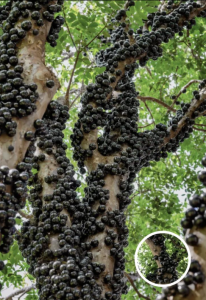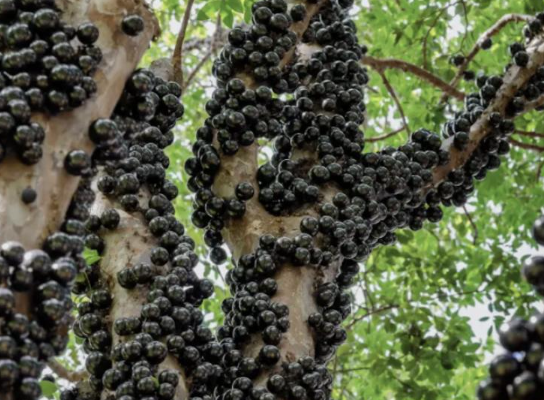“The Tree That Wore Its Secrets Outside”
In the heart of a sleepy Brazilian village, nestled between the folds of a forgotten orchard, stood a tree that refused to follow the rules. It wasn’t tall or majestic. Its bark was rough, its branches modest. But it had a secret—one that made passersby stop mid-step, gasp, and sometimes reach out just to confirm it was real.
The jabuticaba tree bore its fruit not in the usual way—dangling from branches like ornaments—but directly from its trunk. Plump, dark-purple spheres clung to its bark like jewels embedded in ancient wood. It looked like something out of a dream, or perhaps a myth—a tree that had swallowed a constellation and now wore it proudly on its skin.
Locals called it “the tree that blushes,” for when the fruit ripened, the trunk seemed to bloom with color. Children whispered that it had a heartbeat, that it pulsed with stories. Elders said it was a tree of truth, that it grew its soul on the outside.
But for Mariana, a young woman who had returned to the village after years away, the tree was something else entirely. It was a mirror.
She had come back not for nostalgia, but necessity. Her mother had passed, leaving behind a crumbling house and a garden that had long since surrendered to weeds. Mariana, once a city-bound architect with a sharp eye and sharper tongue, now found herself surrounded by silence and soil. She didn’t know what she was looking for—only that she had lost something, and the city couldn’t give it back.
The jabuticaba tree stood at the edge of her property, half-hidden behind a collapsed fence. She remembered it vaguely from childhood, but it had never looked like this. Now, it was in full bloom—its trunk covered in fruit, like a body covered in bruises or blessings.
She approached it cautiously, unsure whether to touch or simply observe. The fruit was cool, firm, and slightly sticky. She plucked one, then another, and tasted. It was sweet, with a hint of tartness—like memory itself.
That night, she dreamed of the tree. In her dream, it spoke—not in words, but in sensations. It showed her a version of herself she had buried: a girl who used to climb trees, who used to believe that magic was real and that truth could be beautiful. She woke with tears on her cheeks and dirt under her nails.
Over the next few weeks, Mariana began tending the garden. Not out of duty, but desire. She cleared the weeds, repaired the fence, and planted herbs her mother used to grow. She spoke to the tree, sometimes aloud, sometimes in thought. It became her confidant, her witness.
One morning, a stranger appeared at her gate. He was a botanist, traveling through the region to document rare species. He had heard rumors of a jabuticaba tree that bore fruit in a way most trees did not—through cauliflory, a phenomenon where flowers and fruit grow directly from the trunk. He asked if he could see it.
Mariana led him to the tree, and he gasped. “It’s extraordinary,” he said. “It defies convention. Most trees hide their fruit in the canopy, but this one wears it like armor. Or maybe like a confession.”
She nodded. “It doesn’t pretend to be anything it’s not.”
The botanist took notes, photos, and samples. Before leaving, he turned to Mariana. “You know,” he said, “trees like this are rare not just because of how they grow, but because of what they represent. They remind us that beauty doesn’t have to be hidden. That sometimes, the most powerful thing you can do is show your truth.”
After he left, Mariana sat beneath the tree and thought about her own truths—the ones she had hidden behind degrees, deadlines, and detachment. She thought about her mother, who had always said, “Don’t be afraid to be seen.” She thought about the city, with its polished surfaces and invisible wounds.
And she made a decision.
She began inviting people to see the tree. Not as a spectacle, but as a sanctuary. Artists came to sketch it. Poets came to write beside it. Children came to play around it. Elders came to remember. The tree became a place of gathering, of storytelling, of healing.
Mariana started a small community project—“Trunk Truths”—where people could share something they had kept hidden. They wrote their truths on paper, rolled them into scrolls, and tucked them into the crevices of the tree’s bark. The tree became a living archive of vulnerability and courage.
One day, a woman arrived with a camera crew. She was a journalist, working on a piece about unusual flora and the stories they inspired. She interviewed Mariana, filmed the tree, and asked, “Why do you think this tree matters so much to people?”
Mariana smiled. “Because it reminds us that we don’t have to hide. That our scars, our stories, our sweetness—they can live on the surface. And that’s not weakness. That’s grace.”
The story aired, and soon, the village saw visitors from around the world. But Mariana didn’t care about fame. She cared about the quiet moments—the way someone’s face softened when they saw the tree for the first time, the way a child’s laughter echoed through the orchard, the way the fruit tasted like memory.
Years passed. The tree aged, but never stopped blooming. Mariana grew older, but never stopped listening. And when she finally passed, the villagers planted a new jabuticaba tree beside the old one. They called it “Mariana’s Mirror.”
Now, two trees stand side by side—one ancient, one young. Both wear their fruit like truth. Both turn heads. And both remind us that sometimes, the most extraordinary thing we can do is let ourselves be seen.


